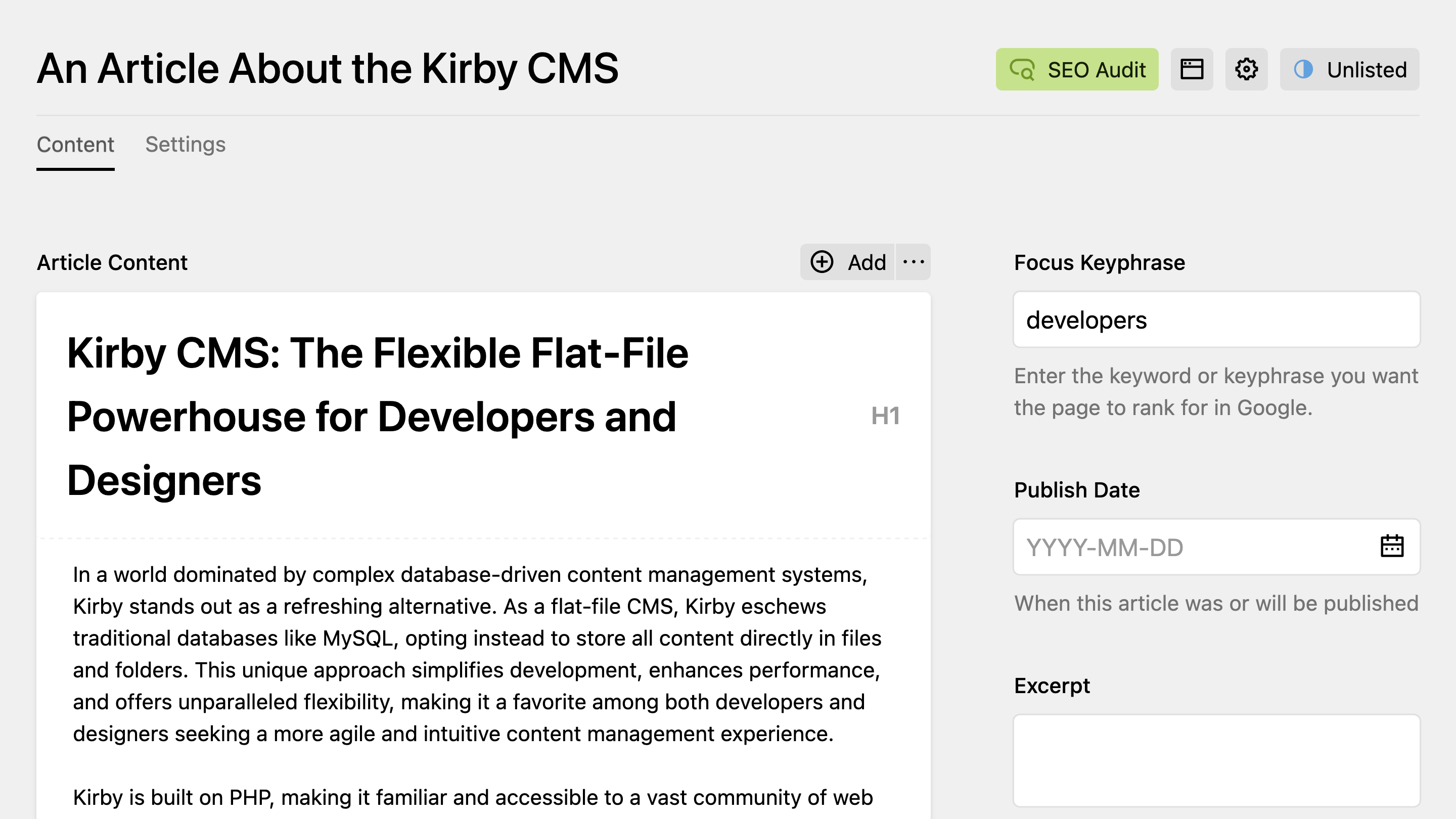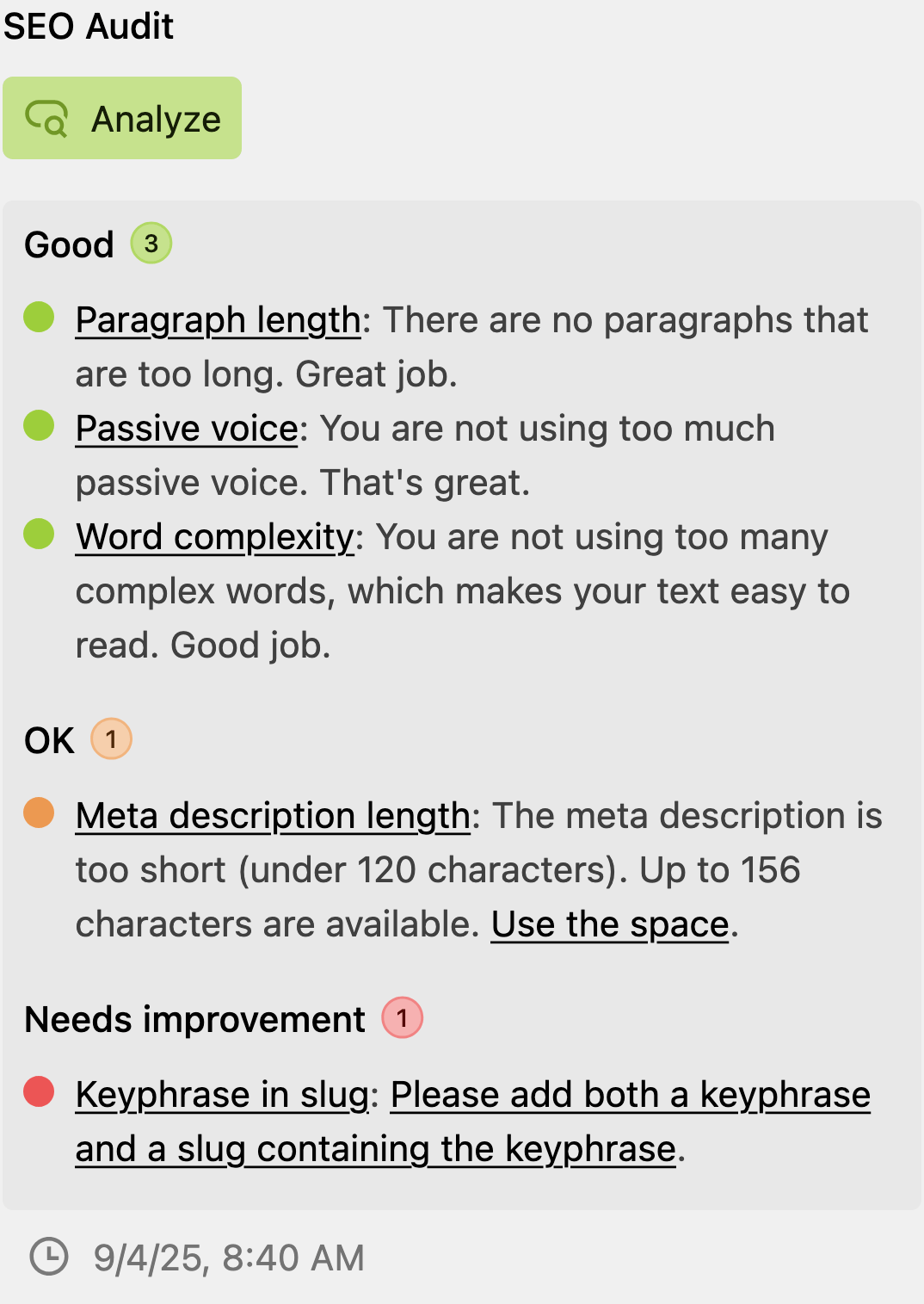View Button & Section
Kirby SEO Audit can be added to Panel views via a view button (recommended) or a section. Both approaches support the same configuration properties and can be used together.
View Button Configuration
The SEO Audit view button can be added to any Panel view (site, page, file) alongside the default buttons like the preview and settings buttons. It provides instant access to SEO and readability analysis.

Clicking the SEO Audit view button immediately runs a SEO and readability analysis for the current page and opens the results in a Panel dialog.
Basic Setup
To add the seo-audit view button to a Panel view, set the buttons option in the corresponding blueprint:
buttons:
- seo-audit
- preview
- settings
- status
Advanced Configuration
When configuring the view button in blueprints, use the available properties as props for the seo-audit button. For example, to define a field for the keyphrase and limit the assessments to a few selected ones, you can use the following configuration:
buttons:
seo-audit:
keyphraseField: metakeyphrase
assessments:
- metaDescriptionKeyword
- metaDescriptionLength
- titleWidth
- images
- textLength
contentSelector: "#main"
preview: true
settings: true
status: true
Shared Properties
keyphraseField String
If you want to include keyword/keyphrase assessments in your SEO analysis, you need to define a field in your blueprint that contains the keyphrase for the given page. Alternatively, use the keyphrase property (see below). Then, the editor can enter the keyword or keyphrase for which they want the page to rank in Google.
Set the keyphraseField property to select which field of the current page model contains the keyphrase.
metaKeyphrase, reference it as metakeyphrase (all lowercase) in the configuration.buttons:
seo-audit:
# Reference the keyphrase field for the view button
keyphraseField: metakeyphrase
sections:
content:
type: fields
fields:
# Define the keyphrase field
metaKeyphrase:
label: SEO Keyphrase
type: text
help: The main keyword you want this page to rank for
seoAudit:
type: seo-audit
# Reference the keyphrase field for the section
keyphraseField: metakeyphrase
assessments property, all keyphrase assessments will be skipped if no keyphraseField is defined.keyphrase String
If you do not want the editor to enter a keyphrase manually, you can set a default keyphrase for SEO analysis. Alternatively, you can use a Kirby query to resolve the keyphrase dynamically.
When to use which:
- Use
keyphraseFieldwhen editors should enter their own keyword per page. - Use
keyphrasefor static keywords or when pulling from a parent page via query.
For example, it is useful to automatically use the page title as the keyphrase:
buttons:
seo-audit:
keyphrase: developers
type: seo-audit
keyphrase: "{{ page.title.value }}"
synonymsField String
Add synonyms to your keyphrase to avoid repeating the same keyphrase over and over again. Not only will readers like this, but it will also help Google to better understand what your content is about.
Set the synonymsField property to indicate which field of the current page model contains the synonyms.
metasynonyms instead of metaSynonyms).buttons:
seo-audit:
synonymsField: metasynonyms
sections:
content:
type: fields
fields:
metaKeyphrase:
label: SEO Keyphrase
type: text
help: The main keyword you want this page to rank for
metaSynonyms:
label: Keyphrase Synonyms
type: tags
help: Alternative keywords and variations
seoAudit:
type: seo-audit
keyphraseField: metakeyphrase
synonymsField: metasynonyms
synonyms Array
Similar to the keyphrase property, which is as an alternative to the keyphraseField, you can set the synonyms property directly in the blueprint. This allows you to define synonyms itself, eliminating the need for a separate field that an editor would have to fill in.
buttons:
seo-audit:
keyphrase: SEO Audit
synonyms:
- Kirby
- SEO
- Audit
type: seo-audit
keyphrase: "{{ page.title.value }}"
synonyms:
- Kirby
- SEO
- Audit
assessments Array
Kirby SEO Audit comes with a set of assessments used to analyze page content. You can enable or disable individual assessments by setting the assessments property. All assessments are enabled by default.
Here is an example of a blueprint configuration that only includes a subset of assessments:
buttons:
seo-audit:
assessments:
# Select the assessments you want to include
- metaDescriptionKeyword
- metaDescriptionLength
- titleWidth
- images
- textLength
- imageKeyphrase
type: seo-audit
assessments:
# Select the assessments you want to include
- metaDescriptionKeyword
- metaDescriptionLength
- titleWidth
- images
- textLength
- imageKeyphrase
contentSelector String
The contentSelector property lets you define a CSS selector that specifies which part of the page should be analyzed. Use this to exclude navigation, footers, or sidebars from analysis – this prevents the plugin from flagging repetitive content that appears on every page.
By default, the plugin uses the body tag to select the content of the page. To analyze only the content of a specific element, set the contentSelector property:
buttons:
seo-audit:
contentSelector: "#main:not(.sidebar):not(.footer)"
type: seo-audit
contentSelector: "#main:not(.sidebar):not(.footer)"
contentSelector also supports querying for multiple elements. For instance, to select all elements with the class .seo-audit-allowed while excluding elements certain elements with the class .seo-audit-ignore, you can use the following selector: .seo-audit-allowed > *:not(.seo-audit-ignore).To debug the content used for the SEO analysis, you can set the log level to info or higher. This will log the extracted HTML to the console:
buttons:
seo-audit:
contentSelector: ".seo-audit-allowed > *:not(.seo-audit-ignore)"
logLevel: info
type: seo-audit
contentSelector: ".seo-audit-allowed > *:not(.seo-audit-ignore)"
logLevel: info
links Boolean
The analysis results contain links to recommendation articles on Yoast.com that explain the individual assessments in more detail. While these links may be helpful, you may want to disable them for privacy reasons or to avoid distracting the editor.
To disable any links in the SEO report, set the links property to false:
buttons:
seo-audit:
links: false
type: seo-audit
links: false
logLevel String
Set the log level for debugging purposes. This property controls how much information is logged to the browser console during the analysis process.
The available log levels are: error, warn, info, debug
buttons:
seo-audit:
logLevel: info
type: seo-audit
logLevel: info
Section Configuration
As an alternative to the view button, you can add a SEO Audit section to your blueprint. The section displays analysis results directly within the page content area instead of in a dialog.
Basic Setup
To add the SEO Audit section to a blueprint, include the following configuration:
sections:
seoAudit:
type: seo-audit
This is how the section will render in the Panel:

Click the Analyze button to perform a SEO and readability analysis on the current page. The analysis results are organized into three categories: Good, OK, and Bad, making it easy to prioritize optimization efforts:

Section-Only Properties
label String
The plugin provides a section label based on the current Panel language. However, you can customize the label by setting the label property.
To change the label, set the label property to your desired text:
type: seo-audit
label: SEO Report
persisted Boolean
By default, SEO reports are saved to the browser's local storage. This allows editors to close the Panel and return later without rerunning the analysis. It is also useful for comparing "before" and "after" results when optimizing content.
To disable saving the analysis, set the persisted property to false:
type: seo-audit
persisted: false